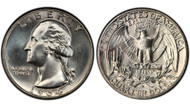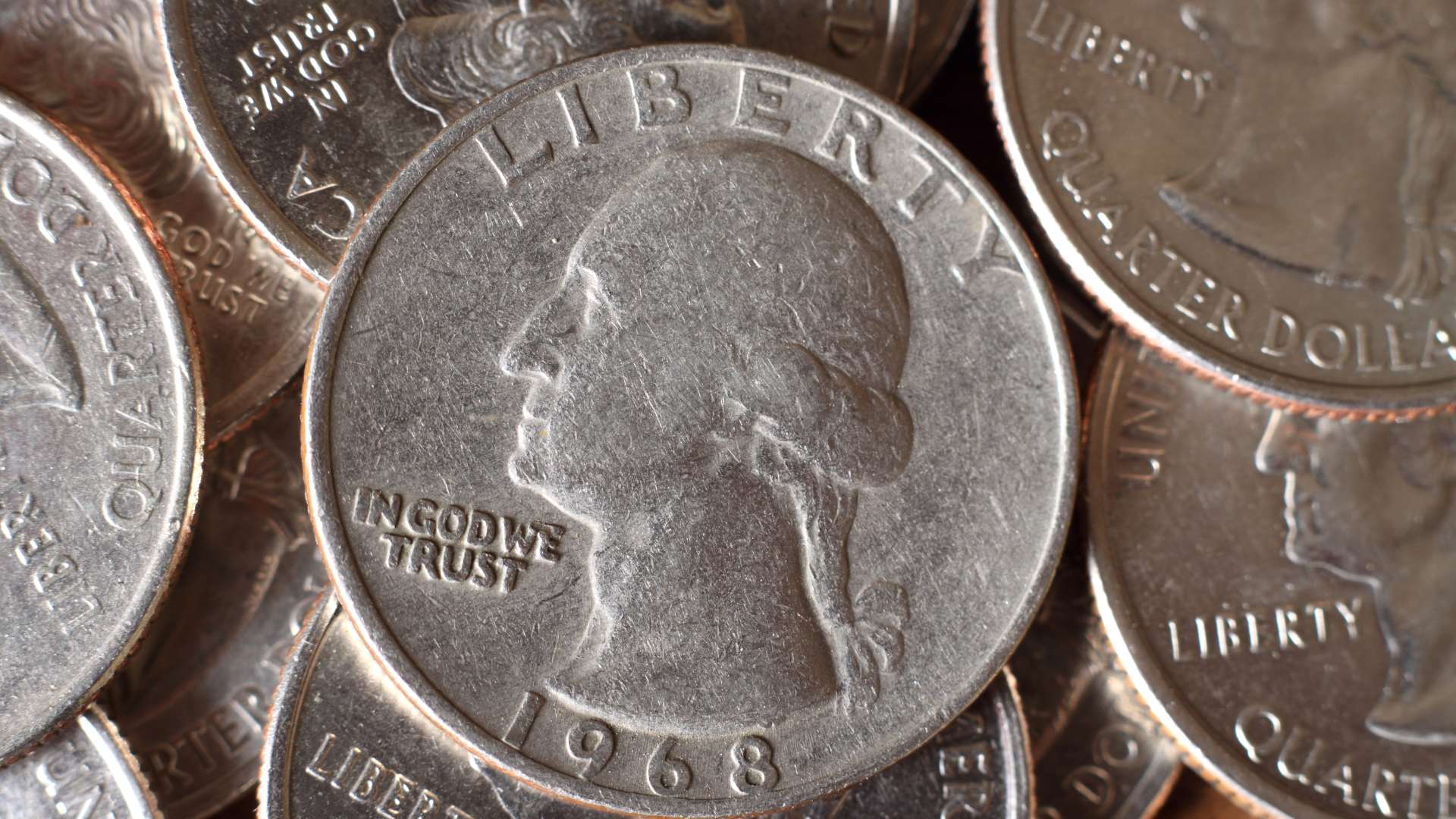When Did They Stop Making Silver Quarters? The Complete History
Posted by Andrew Adamo on Mar 4th 2024
When Did They Stop Making Silver Quarters?
You may ask yourself, what year did they stop putting silver in quarters? Inflation is a hot topic these days, with how it reduces the dollar’s purchasing power, which is a form of currency debasement. But the most significant currency debasement in American history was the removal of 90% silver coinage from circulation in the 1960s, which ended the almost two century use of silver coinage in the U.S. that began in 1792.
Most people, especially coin collectors, know that the last U.S. Mint issued 90% silver dimes, quarters and half dollars are dated 1964, but many likely do not know how these events played out. Nor do they realize that silver coins were actually minted after 1964, yet they continued to use the same date for about two more years. In fact, because this is a complex story that is not well known today, even coin collectors often do not know what year they stopped making silver quarters and other silver coins.
From the 1930s to the 1950s, thanks mostly to the 1934 and 1946 Silver Purchase Acts, the U.S. Treasury was a massive buyer of silver. It acquired billions of ounces of the metal on the open market not just to produce silver coinage for circulation but also to provide backing for silver certificates, which could be redeemed for silver dollars.
How a Silver Shortage Affected Silver Content in Quarters
Things were fine until the early 1960s when a worldwide shortage of silver began to emerge thanks to its industrial applications in rapidly growing economies here and abroad, the pressure of rising silver prices and the demand for silver coins from collectors and speculators was a major factor in when the U.S. Mint stopped putting silver in quarters.
All of this resulted by this time in a massive shortage of silver coins that was identified by the Kennedy administration, which also took the first steps to address it by ending sales of free silver, or silver supplies beyond what was needed to back up silver certificates. It was also the first to consider issuing coinage from another, cheaper material. On November 28, 1961, President Kennedy told his Treasury Secretary: “I have reached the conclusion that silver metal should be gradually withdrawn from our monetary reserves.”
Several key factors provide the main reasons for this silver shortage in the U.S.:
- A booming economy and the widespread use of silver in industry
- The huge expansion in the use of vending machines
- The boom in coin collecting during this period
Coin collectors were often blamed more than anyone else for this situation probably because the numismatic hobby during this period was booming thanks to the debut of major coin publications and the coin roll craze. But a larger part of the problem came from the rapid increase in the use of vending machines in the 1950s and 1960s such as in parking meters, phone booths and snack machines. By this time, that amounted to $3.5 billion per year and resulted in all those coins being sequestered from circulation for long periods.
Keep in mind that as for coin collectors, whose ranks grew in this period from around 2 to 8 million, there were also two key events that resulted in large depletions of our silver coinage that amounted to millions of ounces of the metal.
First was the discovery in the early 1960s of millions of silver dollars, mostly Morgans, in U.S. Treasury vaults that were sold by the bag at face value at banks. Between early 1963 and March 1964, this meant the supply of silver dollars dwindled from 94 million to just 3 million!
The Creation of the Kennedy Half Dollar.
The second event was the issuance of the Kennedy half dollar in 1964. The slain president was almost universally admired and loved by the American public, so when a coin was available as a tangible keepsake and tribute to JFK, it was immediately hoarded by the public. The coin -- of which over 429 million were struck -- barely circulated. In fact, the coin also provided the catalyst for ending the widespread use of half dollars in circulation, which from 1964 were seldom found.
By early 1963, the spot price of silver was still being held at $1.293 - the level at which the bullion content of 90% silver coins was equal to the face value of the coins. But problems began arising when the spot price began to exceed that level due to the shortage and rising demand for the metal. As had been understood by the Kennedy administration, if silver rose in value, those 90% coins would be widely hoarded, resulting in a shortage of coins needed for commerce and potentially a loss of faith in the dollar. This was a critical issue with continuing to put silver in quarters and other circulating coins.
The only reason silver in the U.S. was still held to this level was the fact that the U.S. Treasury was freely selling silver from the government’s stockpiles, but they were rapidly dwindling.
On September 8, 1964, President Lyndon Johnson signed a law that allowed the U.S. Mint to freeze the date that appeared on our circulating coinage. Thus, any silver coinage produced after 1964 would still bear the 1964 date, which the administration thought would help dissuade collectors from hoarding the coins since they would presumably not have numismatic value if the dates were all the same.
But that approach failed to address the key problem of the rising price of silver, which would eventually encourage the public as a whole to hoard those 90% silver coins, not just speculators and collectors, and because too many of those silver certificates had been issued. It was evident that silver had too much value to be used in circulating coins at this point, which led to the U.S. Mint to stop putting silver in quarters.
The Rise of Copper-Nickel Coinage and the End of Putting Silver in Quarters
On July 23, 1965, Johnson signed a law, the Coinage Act of 1965, that authorized the U.S. Mint to start producing dimes and quarters out of a cupro-nickel alloy made with copper, although half dollars would continue to be made with a 40% silver composition. The law also prohibited the use of mint marks for the next couple years, which was yet another ineffective step rooted in a misplaced focus on coin collectors as the source of the problem, including by then Mint Director Eva Adams.
The first copper-nickel quarters were not struck until August 1965 and released that November, while the copper-nickel dimes and 40% silver halves were made in December and released in early 1966. This meant that contrary to the common understanding that silver coinage stopped in 1964 and only copper-nickel coins circulated from 1965, most of the higher denomination coins that circulated in 1965 were still made of silver.
The U.S. Mint stopped making silver quarters in January 1966, and the last 90% silver dimes were made in February of that year.
Meanwhile, thanks to the rapidly dwindling government silver supply, the Treasury could no longer suppress the price of silver below that essential $1.293 level.
As the public began hoarding those 90% silver coins, the government began cranking out massive quantities of copper-nickel coins to fill the void with over 4 billion Washington quarters and 5 billion Roosevelt dimes made from 1965 to 1967.
The administration felt it could at this point stop trying to suppress the value silver, which rose to over $2.00 per ounce and even greater hoarding by the public.
As for those silver certificates, in March 1964 the government stopped redeeming them for silver dollars and instead redeemed them for silver granules or bars, and by June 24, 1968 was no longer required to redeem them for any silver.
Finally, those 40% silver halves – the last remaining silver coins in circulation – would also soon come to a halt as silver’s market value kept rising. In 1969 almost 130 million were struck, but in 1970 they were only made for mint and Proof sets. No more 40% silver halves were made after 1970, thus ending the long run of circulating silver coinage.
Although roll searchers still sometimes find 90% silver quarters in rolls from banks, by the early 1970s the vast majority of those coins had disappeared from circulation.
Sources:
William L. Silber, The Story of Silver (Princeton University Press, 2019)
“Silver and the Coin Shortage,” CQ Researcher, December 2, 1964
Continue Reading:
-
10 Most Valuable Modern Quarters Worth Money
- Guide to Collecting Steel Pennies
- Top 100 Pennies Worth Money
FAQs
What specific measures did the U.S. government take to address the hoarding of silver coins by the public and collectors, besides freezing the date on coins and switching to copper-nickel coinage?
To address the hoarding of silver coins by the public and collectors, the U.S. government undertook several measures beyond just freezing the date on coins and transitioning to copper-nickel coinage. One significant action was the decision to stop redeeming silver certificates for silver dollars, shifting instead to redeeming them for silver granules or bars, and eventually ceasing any redemption for silver in 1968. This move aimed to reduce the direct demand for physical silver from the Treasury, thereby lessening the pressure on the silver supply. Additionally, the government and the U.S. Mint engaged in public relations efforts to encourage the circulation of coins and discourage hoarding, although these efforts were not always successful given the economic incentives to hoard silver as its price rose.
How did the transition from silver to copper-nickel coinage impact the U.S. economy and the public's trust in the currency?
The transition from silver to copper-nickel coinage had several impacts on the U.S. economy and public trust in the currency. Economically, the move helped stabilize the coinage supply and ensured that coins remained available for everyday transactions, which was crucial for the smooth functioning of the economy. However, the change also sparked debates about the value of money and the removal of precious metals from the monetary system, which some critics argued represented a move away from "real" value. Despite these debates, the transition was relatively smooth, and over time, the public largely accepted the new coinage, partly because the alternative materials ensured that coins remained functional as currency rather than being hoarded as commodities.
Were there any significant public reactions or controversies surrounding the cessation of silver in quarters and the introduction of copper-nickel coinage?
Regarding public reactions or controversies, the cessation of silver in quarters and the introduction of copper-nickel coinage did provoke some public and collector debate. Some collectors and silver enthusiasts lamented the loss of silver coinage, viewing it as the end of an era and expressing concerns about the devaluation of the currency. However, the general public's reaction was mixed, with many people accepting the change as a necessary response to the silver shortage and the practical needs of the economy. The government's efforts to explain the rationale behind the change and to ensure a smooth transition helped mitigate some of the potential backlash. Over time, as the new coinage became the norm, the controversy faded, and the focus of collectors shifted towards preserving the remaining silver coins as historical and valuable pieces.


